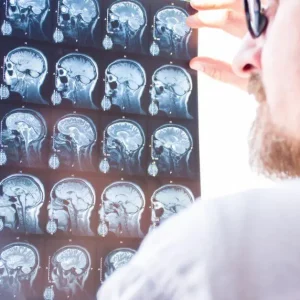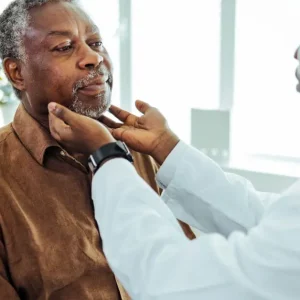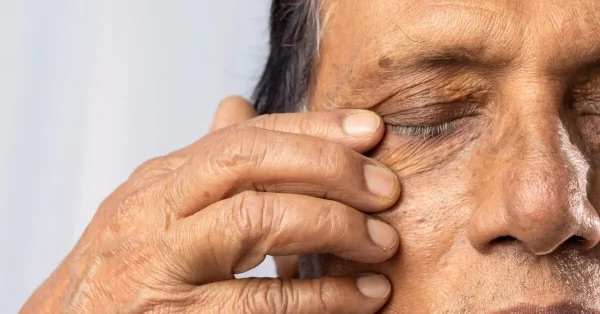A hemorrhagic stroke is a medical emergency caused by the rupture of a blood vessel in the brain, leading to bleeding in or around the brain tissue. While less common than ischemic strokes, hemorrhagic strokes are particularly severe and can lead to significant neurological damage or death if not promptly treated.
This guide breaks down everything you need to know about hemorrhagic stroke—from what causes it and the symptoms to watch, to prevention strategies and treatment options available.
Jump to a section
What Is a Hemorrhagic Stroke
Causes of Hemorrhagic Stroke
Signs of Hemorrhagic Stroke
Diagnosing Hemorrhagic Stroke
Treatment for Hemorrhagic Stroke
Preventing Hemorrhagic Stroke
What Is a Hemorrhagic Stroke?
A hemorrhagic stroke occurs when a blood vessel in the brain bursts, causing blood to leak into the surrounding brain tissue. This bleeding increases pressure within the skull, damages brain cells, and disrupts the flow of oxygen to critical areas.
While ischemic strokes (which are caused by a blood clot in the brain) are the most common type of stroke, hemorrhagic strokes account for approximately 13% of all stroke occurrences. There are two main types of hemorrhagic stroke:
Intracerebral Hemorrhage (ICH)
This type involves bleeding directly into the brain tissue, often caused by high blood pressure. Intracerebral hemorrhage accounts for the majority of hemorrhagic strokes, with most intracerebral hemorrhages occurring in the basal ganglia region.
Subarachnoid Hemorrhage (SAH)
This type involves bleeding in the area between the brain and the thin tissues covering it, typically due to the rupture of an aneurysm on the surface of the brain. It can cause sudden, severe headaches and rapid neurological decline following the stroke.
Causes of Hemorrhagic Stroke
Several factors can lead to the rupture of a blood vessel in the brain. Understanding these causes is key to both prevention and treatment.
1. High Blood Pressure
Chronic hypertension is the most common cause of intracerebral hemorrhage. Over time, persistently high blood pressure puts excessive strain on the walls of blood vessels, weakening them and making them more prone to ruptures.
Managing blood pressure through lifestyle changes and medications is one of the most effective ways to reduce stroke risk.
2. Aneurysms
Aneurysms are weak spots in blood vessels that gradually balloon out over time. These bulging vessels can burst under pressure.While ruptured aneurysms are a leading cause of subarachnoid hemorrhage, an aneurysmal intracerebral hemorrhage is also possible.
Often, aneurysms remain undetected until they rupture, highlighting the importance of regular health check-ups, especially for individuals with a family history of aneurysms.
3. Arteriovenous Malformations (AVMs)
AVMs are abnormal tangles of arteries and veins that disrupt normal blood flow and pressure. These fragile structures can rupture, causing bleeding in the brain
While AVMs are often congenital, they might not cause symptoms until a rupture occurs, making early diagnosis through imaging critical for high-risk individuals.
4. Trauma
Traumatic injuries to the head, such as those from car accidents, sports injuries, or falls, can damage blood vessels and result in a hemorrhagic stroke.
Older adults are particularly vulnerable due to age-related changes in blood vessels and a higher likelihood of being on blood-thinning medications, which can exacerbate bleeding.
5. Blood Disorders
Certain blood disorders, such as hemophilia or sickle cell disease, interfere with normal clotting and can increase the likelihood of a hemorrhagic stroke.
Additionally, medications like anticoagulants, while essential for preventing clots in some individuals, can elevate the risk of bleeding if not carefully managed. Regular monitoring and adjustments to treatment plans are essential to balance these risks.
Signs of Hemorrhagic Stroke
Recognizing the signs and symptoms of a hemorrhagic stroke is critical for seeking immediate medical attention. Symptoms may vary depending on the location and severity of the bleeding but often include:
- Sudden, severe headache (often described as the “worst headache of my life”)
- Nausea and vomiting
- Loss of consciousness
- Weakness or numbness on one side of the body
- Vision problems
- Difficulty speaking or understanding speech
- Seizures
- Confusion or disorientation
- Impaired balance or coordination
While many symptoms overlap, individuals with hemorrhagic strokes are more likely to experience headaches, nausea and vomiting than those with ischemic strokes. If you or someone else experiences these symptoms, call emergency services immediately.
Diagnosing Hemorrhagic Stroke
A rapid and accurate diagnosis of a stroke is essential for effective treatment. Medical professionals use the following methods to identify and evaluate a hemorrhagic stroke:
Imaging Tests
- CT Scan: A quick imaging method to detect bleeding in the brain.
- MRI: Provides detailed images to identify the extent and location of the stroke.
Angiography
Cerebral angiography may be used to visualize blood vessels and locate aneurysms or AVMs.
Blood Tests
These tests help assess clotting ability, detect infections, or determine underlying conditions contributing to the stroke.
Treatment for Hemorrhagic Stroke
Treating a hemorrhagic stroke is all about acting fast to stop the bleeding, ease pressure on the brain, and prevent further damage. The exact treatment plan will depend on where the bleeding occurred, how severe it is, and your overall health. Let’s walk through the key steps in this process.
Emergency Care: Taking Control Quickly
The first priority in any hemorrhagic stroke is stabilizing the patient. In the emergency room, doctors focus on keeping vital functions steady—like oxygen levels, blood pressure, and heart rate. High blood pressure can make bleeding worse, so controlling it right away is crucial.
Medications also play a big role here. Blood pressure-lowering drugs can help minimize the damage, while anticonvulsants may be given to prevent seizures. If you’re taking blood thinners, doctors may use specific treatments to reverse their effects and get your blood clotting normally again.
Surgery: Fixing the Problem at Its Source
In some cases, surgery is necessary to address the cause of the stroke or reduce its impact. If the stroke was caused by a ruptured aneurysm, there are two common procedures to stop further bleeding:
- Clipping: This involves placing a tiny metal clip at the base of the aneurysm to cut off blood flow. It’s a tried-and-true method to prevent additional bleeding.
- Coiling: A less invasive option, coiling uses a thin catheter to insert small coils into the aneurysm. These coils encourage clotting, effectively sealing it off.
If there’s a significant buildup of blood in the brain (called a hematoma), doctors may perform surgery to remove it. This helps reduce pressure inside the skull, giving the brain a better chance to heal.
Rehabilitation: Getting Back to Life
Once the immediate danger has passed, the focus shifts to recovery. Rehabilitation is all about helping you regain your strength, independence, and confidence. It’s a team effort, and the process is tailored to what you need most.
- Physical Therapy: If you’re having trouble moving or balancing, physical therapy can help rebuild strength and coordination. Whether it’s walking, climbing stairs, or simply sitting or standing up, these sessions are all about progress.
- Speech Therapy: Trouble with language or swallowing is common after a stroke, and speech therapy can make a big difference. Therapists work with you on communication skills and safe eating techniques. They may also focus on cognitive skills, such as memory and problem-solving.
- Occupational Therapy: Everyday tasks like getting dressed, cooking, or even using a computer can feel challenging after a stroke. Occupational therapy helps you relearn these skills, sometimes with tools or techniques to make them easier.
Rehabilitation takes time and patience. Unfortunately, hemorrhagic strokes are often initially more severe than ischemic strokes, meaning that there may be more significant and persistent challenges. Rehabilitation might last weeks, months, or even longer, depending on your needs and progress. Although hemorrhagic stroke survivors may require more rehabilitation, they often achieve similar long-term recovery outcomes as those with ischemic stroke based on stroke survival statistics.
While some individuals focus primarily on physical recovery, it is important to remember that rehabilitation is also about learning to adjust emotionally and mentally to life after a stroke.
By combining fast emergency care, effective treatments, and personalized rehabilitation, many people can recover from a hemorrhagic stroke and find their way back to a fulfilling life.
Preventing Hemorrhagic Stroke
While some risk factors like age or genetic predisposition cannot be controlled, many steps can reduce the likelihood of a hemorrhagic stroke. Let’s take a look at some of the most common ways to reduce your risk of hemorrhagic stroke.
1. Manage Blood Pressure
High blood pressure is the leading cause of hemorrhagic stroke, making it critical to keep it under control.
Regularly monitoring your blood pressure at home or with your doctor can help you catch any issues early. In addition to reducing salt intake and exercising, stress management techniques like meditation or yoga can also support healthy blood pressure levels.
2. Avoid Smoking and Excessive Alcohol
Smoking damages blood vessels and accelerates the process of vessel weakening, while heavy alcohol consumption raises blood pressure and increases stroke risk.
Quitting smoking, even after years of use, can significantly improve your vascular health. Limiting alcohol to moderate levels—one drink per day for women and two for men—can further reduce your risk.
3. Maintain a Healthy Diet
A diet rich in colorful fruits and vegetables, whole grains, and lean proteins provides the nutrients your blood vessels need to stay strong. Including foods high in potassium, like bananas and spinach, can help regulate blood pressure.
On the flip side, avoiding processed foods, sugary drinks, and excess red meat is key to reducing inflammation and cholesterol levels.
4. Exercise Regularly
Regular physical activity helps maintain a healthy weight, reduces stress, and keeps your blood pressure in check.
The American Heart Association recommends aiming for at least 150 minutes of moderate exercise each week, such as brisk walking, cycling, or swimming. If you’re new to exercise, start slow and gradually build up your endurance to avoid injury.
5. Control Chronic Conditions
Unmanaged conditions like diabetes and high cholesterol can damage blood vessels and increase stroke risk. Work closely with your healthcare provider to develop a personalized management plan, which may include medication, dietary adjustments, and regular screenings.
Keeping these conditions in check not only reduces stroke risk but also supports overall health.
6. Limit Blood Thinners
While blood thinners are essential for some people to prevent clots, they can increase the risk of bleeding, including hemorrhagic stroke. If you’re taking these medications, follow your doctor’s instructions carefully, and discuss any side effects or concerns.
Regular check-ups and blood tests can help ensure the dosage is right for your needs.
Hemorrhagic Stroke: Final Thoughts
Hemorrhagic strokes are serious and life-altering, but they are not beyond prevention or management. By understanding the risks, recognizing the symptoms, and making proactive choices, you can take control of your health and significantly reduce your chances of experiencing this condition.
If you’re concerned about your stroke risk or have questions about prevention, don’t hesitate to speak with your healthcare provider. Together, you can develop a personalized plan that fits your needs and helps safeguard your brain health for years to come.
Remember, the earlier you start, the more you can stack the odds in your favor for a healthier, longer life.















